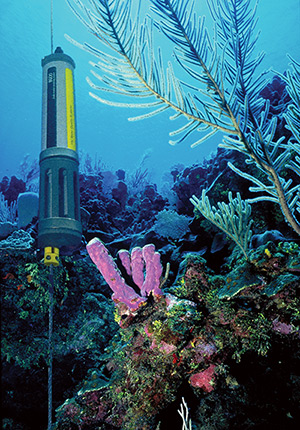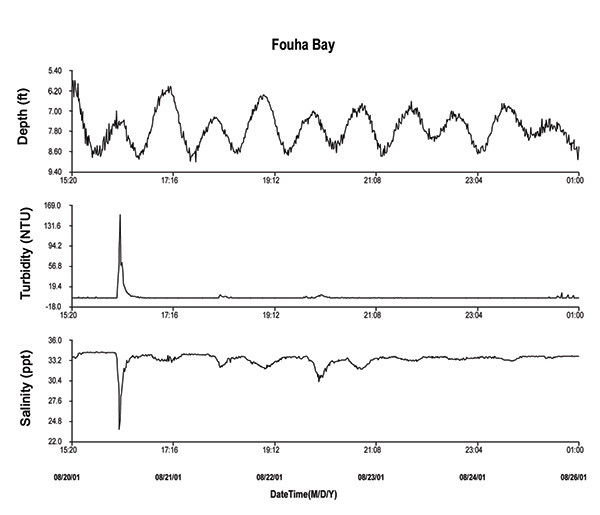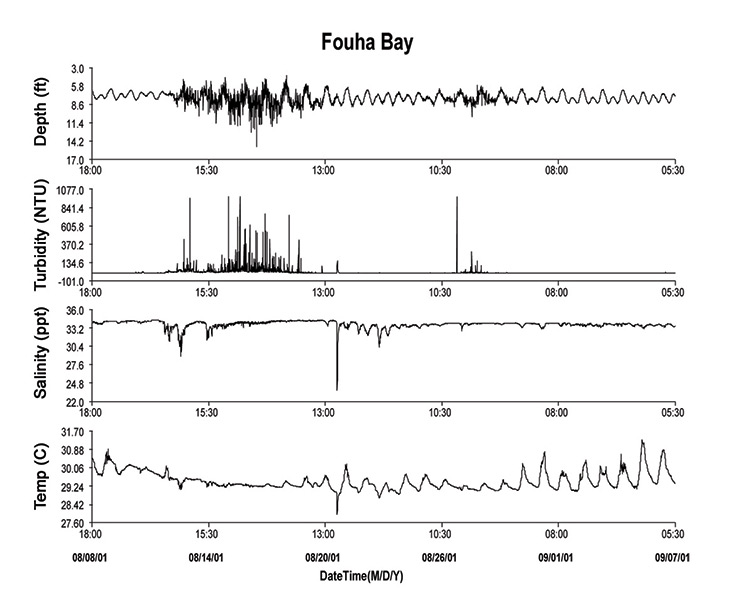Coral Reef Ecosystem Management Integrated with Watershed Based Activities
When the University of Guam Marine Laboratory, University of Hawaii at Manoa, and the Australian Institute of Marine Sciences teamed up to spearhead a U.S. Environmental Protection Agency Science to Achieve Results grant, they needed a site for the federally funded program. The program requires scientists to work directly with governments and communities to develop action plans. The focus of this particular program was to study the degradation of coral reefs due to human impact and to develop a plan to curb the negative effects. 
University of Guam marine biology professor Dr. Robert Richmond and his colleagues chose Umatac, on the southwestern side of Guam, due to its location, impacted reefs, and good historical data on its erosion plight.
The scientists visited Fouha Bay in Umatac to study how sedimentation affects the reef, how long soil is suspended in the water, and how far it reaches onto the reef. With this information, the goal of the project is to revive the reefs and use the project as a model for repairing reefs around Guam and, ultimately, around the world
In order to facilitate this research and unattended monitoring, Dr. Richmond and his team chose YSI multiparameter sondes. The YSI 6600EDS (pictured at right) was added due to its unprecedented stability and calibration longevity even in high-fouling environments. All sondes for the study are equipped with sensors for measuring temperature, conductivity, depth, and turbidity.
YSI's newest sonde platform, the EXO sondes, namely the EXO1 and EXO2 provide even greater flexibility, deployment times, and ease of use over the 6-series family. Deployments can be greatly extended with a central wiper system, wiped conductivity and temperature sensors, anti-fouling copper-alloy sensor guards, copper tape, C-spray, and more to allow for longer water quality monitoring studies without human intervention. (Learn more, 7 Tips to Fight Fouling and Extend Water Quality Sonde Deployments).
The YSI instruments are used to develop sediment budgets within the bay affected by watershed discharges, and are critical to the development of models for sediment and freshwater impacts on coastal coral reefs. Dr. Richmond states,
“We are very pleased with the instruments and since we are funded to expand the studies, we are purchasing additional YSI units.”
The scientific approach to this study includes performing ecological studies on coral reefs as well as laboratory-based bioassays; quantifying levels at which sedimentation and selected classes of pollutants become problematic; studying coastal water characteristics of flow, residence time, and spatial extent of watershed discharge to determine measures that can be implemented to reduce negative impacts; quantifying the societal costs to island communities resulting from watershed and related reef degradation, and testing reef restoration techniques coupled with land-based remediation. The task appears daunting but the team is starting to see progress.
Hunters who set fires in the forest, which sends large amounts of soil onto the reef, are talking about the impacts of this practice. In addition, discussions have started concerning the main road that sends mounds of dirt into the bays, earthquakes, and haphazard land clearing. Local authorities are also beginning a dialog about planting trees to reforest, among other methods, to create conditions necessary to help restore the reefs through thoughtful and well-planned land practices.
The data collected throughout the project demonstrates the effect of short-period rainfalls on salinity and turbidity (Figure 1) and the effects of wave swells on resuspension of sediment in Fouha Bay (Figure 2). Fouha Bay is exposed to open ocean swells which are capable of flushing accumulated sediment approximately four times per year.
Unfortunately, estimates of sediment loads coming from the watershed suggest the Bay bottom is covered nearly eight times per year. Resuspension of sediment during periods of southern wave swell was found to be a substantial problem in the Bay, killing additional corals and preventing larval recruitment. Overfishing of herbivorous fishes has added to the problem due to the overgrowth of sediment-covered substrata with fleshy algae. Recovery of the Bay will require a combined reduction in sediment input as well as the establishment of a moratorium on catching herbivorous fishes.

Figure 1. Effect of a short period of rainfall on salinity and turbidity in Fouha Bay, Guam.

Figure 2. Effects of wave swell on the suspension of sediment in Fouha Bay, Guam.
The main impetus behind collecting accurate water quality data has been to establish educational programs and materials to meet program requirements to educate and cooperate with local governments and community members. Several important educational opportunities have presented themselves. The Village of Umatac Mayor, along with the municipal planning council, was presented the results of the Fouha Bay study.
Meetings were also held with community members surrounding the Ngerikill estuary, including traditional leaders and local fishermen. The research received the “blessing” of the community (a necessary element in Palau) and a local fisherman was hired to help look after the equipment once it was deployed.
The program received an educational extension boost when the publisher of the regional newspaper, The Pacific Daily News, agreed to take on coral reef health and integrated watershed management as a special project for nine months. A full-page was devoted to these environmental issues every Monday with additional activities scheduled bi-monthly.
To date, the project has made great strides in raising awareness and creating a level of understanding between poor land-use practices and coral reef degradation. Armed with accurate data from YSI instruments and a scientific understanding of the reef ecosystem dynamics, runoff effects will be increasingly minimized, bringing about improvements in coral reef production, growth, stability, and diversity. Coral can handle runoff that occurs naturally during typical rainfall events. However, Dr. Richmond points out that it’s vital to return water quality to its former purity through mitigation and better planning. If the water is clean enough, the coral will grow back, but people need to make saving the reef a priority and push recovery efforts.
Dr. Richmond states, “We can save the reef.”

Additional Blog Posts of Interest
The Evolution of Water Quality Monitoring [Free Ebook]
Coral Reef Sponge Science - A Cure for What Ails You?
Monitoring Coral Reefs in the Caribbean: Protecting Our Rainforests of the Ocean
10 Tips to Prevent Biofouling on Water Quality Instruments